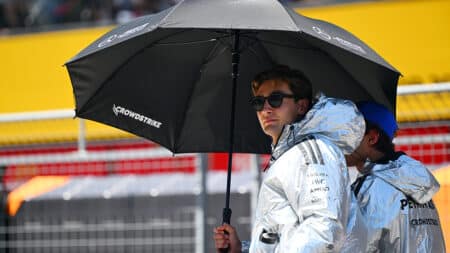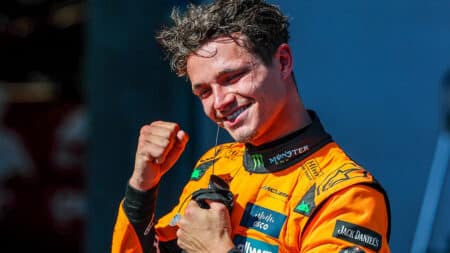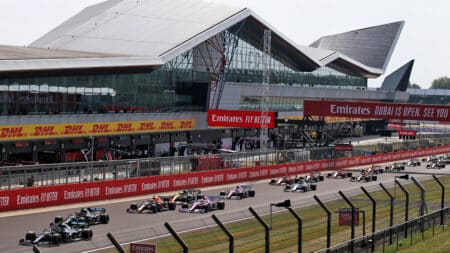
2025 is F1’s most polite title battle ever – Up/Down in Austria
Describing this year's championship race as a 'battle' might be slightly over-egging it, writes James Elson
How many Formula 1 drivers have admitted to having a coach? Not many. In fact, you could probably count them on two hands. The fact of the matter is, though, a huge percentage of professional drivers have coaches, including established F1 stars. You’d imagine lessons would be in a GP2 car, a kart perhaps, with the teacher pouring over the data and offering tips and expertise. Not quite…
Twelve of the current 20 F1 drivers use/have used one man, a strip of Bruntingthorpe Proving Ground and a Vauxhall.
Let’s start with the ‘one man’. Meet (if you haven’t already) ex-racer Rob Wilson. He used to live in New Zealand, but “as soon as he could” he got on an aeroplane and flew to the UK. “I’d just turned 20 and I’d always wanted to race. I didn’t want to race in New Zealand, though, because you could end up being a national champion and have no idea where you were. We had good drivers, but when the Tasman Series had the big names in it the locals would be one-and-a-half laps behind in nearly similar cars.

© GM Company
“I did a bit of work on some car magazines, road testing Ford Falcons and the like, and eventually there was an advertisement in Autosport for a driving competition. I won that and got into Formula Ford, won some races in Formula 3, but then I realised money was part of it. I got bought out of two Grands Prix in 1981 and suddenly I couldn’t get a job as a window cleaner.
“One of those was a drive in the Belgian Grand Prix, which [Michele] Alboreto bought on the Wednesday before the race. I was supposed to be in the Tyrrell and the only thing that could have gone wrong was if Alboreto turned up with £200,000. And he did!
“I took a break, played in a band and then a couple of years later saw that a lot of my contemporaries were in F1. Nearly two years after quitting the phone rings and it’s Ken Tyrrell. I thought ‘what does he want now?’ He asked, ‘you play in a band, don’t you?’ Well, yes… ‘Michele has just signed for Ferrari with Arnoux so we’re doing a leaving party. Would you come and play?’” Rob, by this stage, is laughing uncontrollably about the whole situation.
He realised that his F1 dream was all but over so his thoughts turned to “anything I got called to race. I did everything and popped across to America. I made quite a good living there for 15-20 years. I did loads of Daytonas, loads of Sebrings, and you got paid well. It was happy racing as well.

Rob at Daytona, 2004
“Near the end of the 1980s I was testing cars for Formula 3 teams and one of those was for Bowman at Silverstone in 1988. The car stopped and I was standing at Stowe – when it was a proper corner – and I was watching Gary Brabham and Rickard Rydell. I was just thinking, ‘Gary is on that throttle really early’. I had a stopwatch with me so I started timing them both and Gary wasn’t as fast.
I had a long time to watch and I came up with a way to fix it. When I went back to the pits I told him and he went faster. I wasn’t a threat because I’d left F3 10 years before, so the team got us together in a road car. We went to Goodwood and we started like that. Luckily it wasn’t me wanting to be a racing driver, it came from a genuine desire to make them better.
“Since then it’s been more a matter of whether you can communicate it and break down all the elements. How do you get the person to do it? Over the next 27 years it’s evolved and it’s become an obsession. I love it.”
As coaches go, Wilson’s one of the best known and carries a mythical air about him since he teaches F1 drivers and doesn’t have any contact details listed online. A quietly spoken man with an encyclopaedic knowledge of London streets (“we drove everywhere in the band”), he’s someone you can spend all day chatting to. He’s never flustered, never raises his voice, but loves his coffee and cigarettes.

With Phil Hill at Goodwood, 2006
So why a Vauxhall? For years Wilson used whichever cars he could get his hands on, but soon settled on Vauxhalls as they “were by far and away the best cars for the job”. One day he was walking out of Waitrose and bumped into Simon Hucknall, Vauxhall’s PR manager. They’d known each other for years and Wilson came over to admire the latest offering.
“Skodas were good, Volkswagens were OK, but the best thing was an Astra or an Insignia.” Being a motor sport fan and seeing a mutual benefit Hucknall decided to trial a supply of cars. The ones he had available had already done quite a bit of work because they were, cough, ex-press cars, but they are still going, having done 5000 track miles. The Le Mans 24 Hours this year was ‘only’ 3345.
“It’s a lot of hard mileage,” admits Wilson. “All we’ve had to fix are the pads and discs. Even that’s not particularly fair because they get so hot they glow bright red. We always do a cool down lap very few laps, but we never cool them down totally so it’s very hard on them. Even the F1 drivers say ‘blimey, this is a good car!’”
I’ll admit straight away that I’ve never had a huge affinity for Vauxhalls. I’ve driven quite a few, but never for a prolonged period. Recently, though, I went to Knockhill to test the new Vauxhall Corsa VXR. I’m not one to test cars usually, but seeing as there was a motor sport angle I ventured north. Vauxhall is an interesting case because, not that deep down, they love their motor sport.

© GM Company
1984 DTM champion Volker Strycek is the performance director for the VXR brand and the Corsa was ready to do hillclimbs and sprints. It really was a road car that you could take on a track day, safe in the knowledge that your biggest worry would be overheated brakes. And not ploughing into a tyre barrier with the car you needed to get to Tesco the following day. As with any road car that can go on a track, or a race car that can be driven on the road, there are always compromises. But fewer than you’d imagine.
I digress… Back to Bruntingthorpe and Wilson’s tuition. Everyone drives in a slightly different way, so if you went to see him, he may tell you totally different things. The general philosophy with me, though, was always to try and get the car straight. This sounds simple, but bear with me…
Even when you’re turning the wheel very slightly the tyres cause more friction and therefore hamper your acceleration. With this in mind he persuades you to carry on straight when exiting a corner despite what’s coming up. Take Druids at Brands Hatch as an example – you’ll exit the corner on the left-hand side of the track, but while Graham Hill is a left-hander you stay on the left for as long as possible. By doing this there’s slightly less friction coming from the tyres crossing the track so you gain time. Watch F1 drivers and quite a few of them do exactly this nowadays.
He also tries to make you ‘introduce’ the three big inputs – braking, steering and the throttle. By doing this very gently before braking hard, steering into the apex or hitting full throttle you transfer the car’s weight and help it cope with whatever it’s about to be faced with. That all makes sense and it’s relatively easy to get your head round.
What wasn’t was his approach to racing lines. Instead of taking the angle of least resistance he teaches you to get the corner done quicker by increasing your turning angle briefly before coming out of the corner completely straight. Again, even a gentle turn on the wheel will cause unnecessary friction.
Admittedly, my driving’s of a standard that means my lap time improvements can be measured in minutes rather than seconds, but Wilson’s tuition helped me look almost respectable by the end (a truly amazing feat).
The only problem was that after an early discovery of our mutual love of random facts, we probably did a lot less driving than most. Rob, if you’re reading this, do you remember our conversation about why we drive on the left? Did you know about Savoy Court in London? In 1902 Parliament decreed that when you were on it you should drive on the right so that theatre goers could get out of their carriages quicker…

Describing this year's championship race as a 'battle' might be slightly over-egging it, writes James Elson

You had to read between the lines at the 2025 Austrian Grand Prix as George Russell dropped hints over about his dissatisfaction, and F1 sent a message to FIA president Mohammed Ben Sulayem

From zero to hero: in a pacy McLaren, at one of his favourite F1 circuits, Lando Norris picked himself up from a disastrous Canadian race to reign supreme in the 2025 Austrian Grand Prix

Full F1 schedule for the year, including the next F1 race of 2025: the British Grand Prix at Silverstone, the whole calendar and circuit guides for the 24-race Formula 1 season